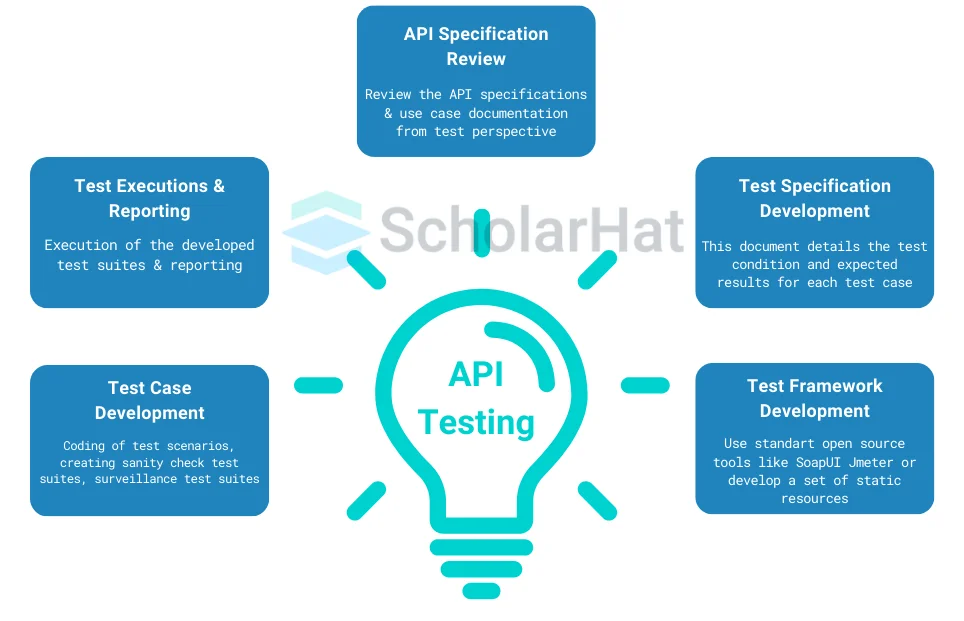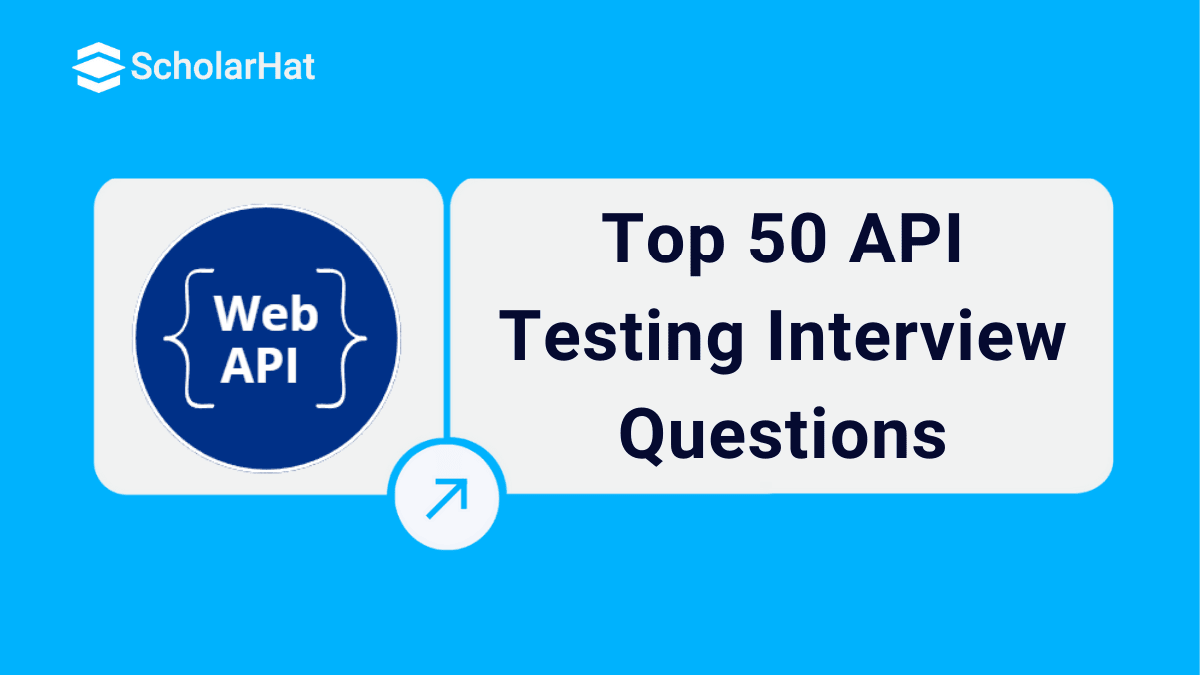08
JanTop 50 API Testing Interview Questions
API Testing Interview Questions
API testing is a crucial aspect of software testing that focuses on confirming application programming interface (API) performance, security, and usefulness. API testing is making direct calls to the API and analyzing the answers to make sure they provide the desired results, in contrast to typical testing techniques that engage with an application's user interface.
In the Web API tutorial, Our specialists created these interview questions using a real-time study of the most frequently asked questions in today's technical rounds. The questions' complexity is progressively increasing from fundamental thread notions to sophisticated ideas like context switching. It will assist you in gradually developing your thoughts.
API Testing Interview Questions for Freshers
1. What is an API?
Application Programming interfaces is a method that helps software systems communicate with one another.
- It is a group of operations that may be carried out by an additional software application.
- Without disclosing internal specifics, it receives a request from the user and responds.
2. What is an API Testing?
Software testing that assesses an API's functionality, speed, and security requirements is known as API testing. It evaluates it both directly and as part of an integration test. The goal is to investigate many endpoints, including online services and databases.
3. How many types of API Testing are provided?
Multiple types of API testing are:
1. Web API: These APIs are frequently used to create web apps as they are made for online communication. GraphQL, SOAP, and RESTful APIs are a few examples.
| Read More: |
| What is Web API, and why should it be used? |
| Difference between SOAP And REST APIs |
2. Library APIs: These APIs offer pre-built classes and methods for common activities and are used in software development. The requests library for Python, the JDBC API for Java, and the Entity Framework for .NET are a few examples.
3. Partner API: It is shared with specific business partners, usually with stricter access controls and usage agreements compared to public APIs.
4. Operating System APIs: The core operating system of a device or server can be accessed using these APIs. The Android, iOS, and Windows APIs are a few examples.
5. Hardware APIs:These APIs are used to communicate with hardware, including printers, cameras, and sensors. A few instances include GPIO APIs, Bluetooth APIs, and USB APIs.
| Read More: |
| Comparing Asp.Net Web API Routing and Asp.Net MVC Routing |
| Passing multiple complex type parameters to ASP.NET Web API |
4. Which protocols are amenable to API testing?
The protocols are :
- SOAP (Simple Object Access Protocol)
- JMS (Java Message Service)
- UDDI (Universal Description, Discovery, and Integration)
- HTTP (Hypertext Transfer Protocol)
- REST (Representational State of Resource)
5. How does API work?
The working of API follows:
- The user submits queries to the API.
- It handles the request, maybe involving database interaction, data processing, data validation, etc.
- The source receives the response back.
6. What is the difference between API and Web Service?
| Factors | API | Web Services |
| Answer | Application Programming Interfaces, or APIs, serve as an interface for data between two programs. | Another type of API that has to be accessible over a network connection is web services. |
| Protocols Support | Support for HTTP/s protocol. | Support for HTTP protocol. |
| XML Support | Supports XML and JSON both. | Supports only XML. |
| Hosting Platform | It can be hosted on IIS and self. | It can be hosted on IIS. |
| Usage | It serves as a communication interface between two apps. | It is utilized for XML-RPC, REST, and SOAP communication. |
6. What are the benefits of API Testing?
- Quick Bug fixes
- Reducing Cost
- Better test coverage
- Universal Language Support
The Common tools used for API testing are:
- Postman:A popular tool for API design, testing, and documentation. It offers an easy-to-use interface for submitting requests, reviewing answers, and setting up automated tests.
- Swagger:A commonly used tool for RESTful API design, development, and documentation. It offers a visual editor for creating documentation and creating contracts for APIs.
- SoapUI: An accurate testing tool for RESTful and SOAP APIs. In addition to offering sophisticated testing capabilities like data-driven testing and security testing, it supports a wide range of protocols, message formats, and authentication techniques.
8. What is a RESTful API?
Representational State Transfer, or RESTful API, is an architectural paradigm used in networked application architecture. It is predicated on a collection of limitations that make interoperability, scalability, and simplicity possible.
9. What is a SOAP API?
The Simple Object Access mechanism, or SOAP API, is a mechanism used to exchange structured data in web services implementations. It offers a set of guidelines for message exchange, error management, and security and employs XML as its message format.
10. What is Latency in API testing?
In API testing, latency is the length of time it takes for a request to reach the server. A quicker reaction time enhances the user experience.
11. What is an API testing framework?
An API testing framework is a collection of pre-established guidelines, practices, and instruments that offer an organized method for creating, putting into practice, and running API tests.

12. What is XML, and when is it used in API testing?
Extensible Markup Language, or XML, is a set of specifications for encoding texts in a machine- and human-readable format. When APIs need that data be sent in XML format, XML is utilized in API testing.
13. What are the common HTTP methods used in API testing?
The common HTTP methods used in API testing are:
- POST:On an API, it's used to generate fresh resources or data.
- GET: This method is used to get resources or data out of an API.
- PUT:An API's existing data or resources can be updated using this method.
- PATCH: This method updates resources or data partly from an API.
- DELETE: This command is used to remove resources or data from an API.
14. Describe the role of headers in API testing?
In API testing, headers are crucial since they offer extra details that aren't in the body of the request. Herders are crucial for regulating how the server responds to requests, supplying authentication details, and supplying metadata related to the request or answer.
15. Which authentication techniques are frequently employed in API testing?
The common authentication techniques used in API testing are:
- Basic authentication: This entails submitting the base64-encoded username and password as part of the API request headers.
- Token-based authentication: After successful authentication, this entails providing the client with a token, which is included in ensuing API calls for permission
- OAuth: This popular authorization system allows access privileges to be transferred across entities without requiring the disclosure of login credentials.
16. Describe the purpose of authentication in API testing.
API authentication is the process of confirming the identity of people requesting access to an API using a mix of technologies. Before allowing access to protected resources, the requester's identity is verified by the software protocol.
17. What is an API framework?
A software developer can create apps for a particular platform by building upon an API framework. It is specified in the configuration file, which includes a list of all the APIs that must be enabled in order for a certain program to operate.
18. Why is JSON frequently used in API testing, and what does it mean?
JavaScript Object Notation, or JSON, is a simple format for exchanging data that is frequently used in API testing. Since JSON makes efficient data serialization and deserialization possible, it is often used in RESTful APIs and is, therefore, perfect for API testing.
19. How do headers fit into API testing?
In API testing, headers are crucial for regulating and managing how API requests and replies behave.
20. What is an API endpoint?
An API endpoint is a particular Uniform Resource Identifier (URI) or URL that designates a certain resource or service that an API offers. It serves as a hub where clients may communicate with APIs to send requests and get answers.
| Read More: |
| Difference between WCF and Web API and WCF REST and Web Service |
API Testing Interview Questions for Intermediate
21. What is API mocking?
API mocking is the technique of mimicking an API endpoint's behavior during testing without actually calling the real API. It is beneficial in the early stages of development.
22. Describe the purpose of the request and response headers in API testing?
The content type, caching, authentication, and other options are specified in the request headers. The response header may provide details about caching, the server, and other topics.
23. Why is API mocking used in API Testing?
- Applications that depend on external APIs can benefit from the usage of mock APIs.
- Mock APIs are helpful for developers to conduct unit testing and pinpoint the early phases of development, as well as for testers to organize and verify test executions.
- When the entire API must be made available for user testing prior to moving it into the development stage, mock APIs come in handy.
24. What are the benefits of using API mocking in API testing?
- Development stage: API mocking is helpful for modeling unexpected behavior and external dependencies.
- Functional stage: API mimicking is helpful in ensuring that the API is ready to handle extreme scenarios, identify any errors, and confirm that the API functions as intended.
- Non-functional stage: API mocking enables the assessment of an API's response times and performance across a range of situations.
- Enables API demonstration: Before releasing the program, developers may show clients how to use an API by using API mocking.
25. How can you make sure your tests' APIs are secure?
You can make sure your tests' APIs are secure by:
- To encrypt data sent between a client and a server, use secure communication protocols like HTTPs.
- Establishing authentication and authorization procedures correctly is crucial to guarantee that only authorized users may access the API endpoints and carry out the allowed operations.
- It is imperative to ensure that any input data included in API requests is appropriately permitted, verified, and sanitized in order to thwart cross-site scripting and injection attacks.
26. Why are the request and response bodies used in API testing?
The payload, or data that is transmitted in the request and response messages, is contained in the request and response body during API testing. The data supplied by the API in response to a request is contained in the response body, whereas the request body is used to convey data from the client to the server, such as input parameters or data to create or change resources.
27. When testing APIs, how do you handle dynamic values like timestamps or random data?
Techniques like data-driven testing, parameterization, or test data management can be used to handle dynamic values in API testing, such as timestamps or random data.
28. Why are query parameters used in API testing?
In API testing, query parameters are used to pass extra arguments in the request's URL. By using these options, you may alter how the API call behaves, including how results are sorted, filtered, and paginated.
30. In your API testing, how do you handle incorrect responses?
To handle incorrect responses in API testing:
- Clear error messages: Providing concise and informative error messages that outline the problem's source and fix is one of the best ways to manage error answers.
- Error logging: The best practice in API testing is to use error logging and monitoring tools that can assist in tracking, analyzing, and fixing issues.
- Use consistent error codes: It's critical to employ error messages that are clear, concise, and specify the kind and seriousness of the problem.
31. What is monitoring for APIs?
API monitoring is the processof obtaining insight into an API's functionality, availability, and performance. These tools aid with application performance analysis and API performance improvement.
32. What is API versioning, and how does API testing benefit from it?
API versioning entails adding a version number to the API endpoint or headers to maintain backward compatibility. It oversees the gradual modifications to the API.
- It guarantees that the appropriate API version is being tested.
- It guarantees that the current client apps won't be affected negatively by API modifications.
33. What use do HTTP status codes provide in testing APIs?
HTTP status codes show the success or failure of a particular request. These are inserted into a page's HTTP header to inform the browser of the request's outcome.
34. Why is input validation crucial for testing APIs?
When testing APIs, input validation is crucial since it keeps bad data out of the system. Preventing harmful activities such as injection attacks is crucial. Automated tools or manual labor can be used for this.
35. Cross-site Request Forgery (CSRF): What is it?
An attack known as cross-site request forgery compels users to carry out unauthorized actions in online applications where they are permitted to do so. This attack exploits the web application's confidence in an authorized user.
API Testing Interview Questions for Experienced
36. In API testing, what is cross-site scripting (XSS), and how can it be avoided?
A vulnerability known as cross-site scripting (XSS) occurs when malicious scripts are inserted into online sites. By correctly verifying and sanitizing user input in API queries, it may be avoided.
37. What is contract testing for APIs?
One kind of testing called API contract testing looks to record the API discussion between the API provider and the API consumer. Postman, Swagger, and other similar technologies can be used to do it.
38. How can CSRF in API testing be avoided?
CSRF is avoided by:
- CSRF tokens: CSRF tokens can be used to stop CSRF attacks. These are the random tokens, which must be huge random values and unique for each user session in order to make guessing challenging.
- SameSite cookies: A browser security feature called SameSite detects when cookies from one website are included in requests coming from another website.
- Referer-based validation: The HTTP referer header serves as a defense against cross-site request forgeries (CSRF) by confirming that the request came from the application's domain.
39. Which best practices apply to API testing?
Appropriate input validation, authorization and authentication, error management, security testing, access controls, and frequent updates and patches are examples of best practices for API testing.
40. How are API versioning policies handled in your tests?
By providing versioning information in API endpoints or headers and guaranteeing backward compatibility to prevent damaging already-existing functionality, API versioning may be managed in tests.
41. What methods are there for dealing with retries and API timeouts in tests?
Establishing suitable timeout limits, implementing retries with backoff methods, and graciously accepting incorrect replies are some techniques for managing API timeouts and retries in tests.
42. Why is contract testing for APIs important?
- When there are several modules involved, scaling and system maintenance become more challenging.
- Integration testing takes a while to design and produce results, particularly when testing communication modules is required.
- Multiple module debugging is a very demanding undertaking. It might occur that while troubleshooting a problem, a module other than the one under test is being used.
43. What is API performance testing, and why is it important?
Software testing that assesses an API's performance, such as response time, throughput, etc., under certain circumstances is known as API performance testing. You may use JMeter, Gatling, and other technologies for this. It is important because of :
- API stability and overall performance are enhanced via API performance testing.
- It facilitates the identification of the API's strong and weak points by offering insight into the API's overall performance.
- Determining the effects of modifications and identifying performance concerns is helpful.
- It contributes to ensuring that the API is adaptable and strong enough to meet real-world requirements.
44. What role does API documentation play in the testing of APIs?
An in-depth technical document that explains the API is called API documentation. It offers updates on the API lifespan, such as new versions, and gives guidance on how to utilize and integrate API successfully. It is the main source of information describing the capabilities of the API and how to use it.
45. How are upgrades and modifications to the API handled in your tests?
Before sending changes to production, API modifications and upgrades may be managed in tests by upgrading the test scripts, retesting the relevant capabilities, and making sure backward compatibility is maintained.
46. When performing regression testing, how do you prioritize the API test cases?
- Choose test situations where errors occur often.
- Choose test examples that have essential features.
- Choose test situations where code changes often.
- Go over complete test flows.
- Choose a risk-based testing strategy.
47. List the challenges you observed when undertaking API testing?
- Constructing pointless tests: It could be quicker to construct tests without taking into account how the APIs will be used in the near future.
- Initial API testing setup: Establishing an API testing setup calls for a certain degree of teamwork and experience.
- Not adding API dependencies: One of the biggest challenges in API testing might arise from neglecting to incorporate API dependencies in the testing approach.
- Data not being validated: It is conceivable for API tests to pass yet for API replies to contain incorrect data. Making sure the API is producing accurate data is crucial.
48. What does the term "input injection" mean to you?
Through Android's accessibility APIs, a malicious application can utilize input injection to imitate user interaction by injecting input into the user interface. Denial of service attacks or entire webserver compromises may result from it.
49. How is API Load Testing carried out?
API load testing is a type of performance testing used to assess an application's resilience to changing user loads. To determine if the application can handle the load while preserving consistency in response times and not compromising functionality, several users are simulated contacting the API simultaneously.
50. What is the test environment of API?
The testing team examines API quality in the testing environment, which may include a test database, a load balancer, a localized gateway, and a server.
| Download This PDF - API Testing Interview Questions PDF By ScholarHat |
If you are preparing for the ASP.NET Web API Interview, this ASP.NET Web API Interview Questions and Answers Book can really help you. It has simple questions and answers that are easy to understand. Download and read it for free today!
Conclusion
We have thus included the most often-asked interview questions and answers for API testing, ranging from simple to complex, for all interested candidates. If you are looking to enhance your software testing experience further, then we highly recommend you to check ScholorHat’sFull-Stack Java Developer and MERN: Full-Stack Web Developer.
FAQs
- Basic Authentication
- OAuth
- JWT (JSON Web Tokens)
- API Keys
- Session Tokens
- Postman
- SoapUI
- Rest-Assured
- JMeter
- Katalon Studio







